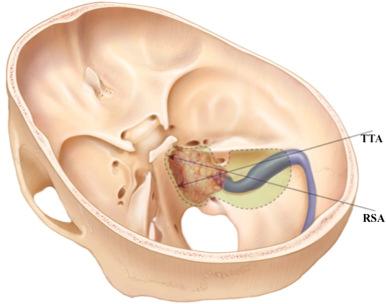Physical Address
304 North Cardinal St.
Dorchester Center, MA 02124
© 2018 Elsevier Inc. All rights reserved. Please note that the copyright for the original figures submitted by the contributors is owned by Contributors.
The retrosigmoid approach (RSA) provides a wide exposure of the cerebellopontine angle (CPA) cistern. Meckel’s cave, parasellar region, and upper clivus can be exposed via its superior extension, also called retrosigmoid intradural suprameatal approach (RISA). In addition, by dividing the tentorium, further superior exposure toward the posterior portion of the middle cranial fossa can be obtained. However, exposure of the petroclival region, which lies anteromedial to the CPA, is often very limited. Therefore, the RSA is not commonly indicated for resection of most skull base chordomas and chondrosarcomas ( Fig. 18.1 ).

This chapter will discuss the role of the RSA in the surgical management of skull base chordomas and chondrosarcomas, emphasizing indications and techniques as well as specific postoperative care. Ultimately, this chapter should guide the reader in selecting the most appropriate treatment strategy for tumors with significant posterolateral extension into the posterior cranial fossa.
The RSA can be indicated for petroclival chordomas and chondrosarcomas that extend posterior, into the CPA cistern, particularly when the brainstem is displaced to the contralateral side and the facial-vestibulocochlear nerve bundle is displaced inferior and posterior. In this situation, often associated with larger tumors, the surgical corridor is enlarged thus facilitating exposure of the petroclival region and anteromedial surface of the brainstem. For tumors with a Meckel’s cave component, drilling of the suprameatal tubercle (e.g., RISA) will enable the surgeon to safely mobilize the trigeminal nerve and access the region.
Preoperative assessment must include a complete neurological evaluation. Special attention must be dedicated to the cranial nerves located within the CPA cistern or its surrounding regions, especially the trigeminal (V) and facial (VII) nerves. A formal ophthalmological evaluation can be indicated to assess the nerves of ocular movement: the oculomotor (III) and trochlear (IV) nerves are related to the lateral pontomesencephalic arachnoidal membrane, which represents the superior edge of the cistern, whereas the abducens (VI) nerve ascends in the most medial aspect of the cistern next to the anterior pontine arachnoidal membrane. A pure-tone audiogram with measure of speech discrimination should assess the integrity of the vestibulocochlear nerve bundle (VIII) and laryngeal endoscopy is needed to assess the glossopharyngeal (IX) and vagal nerves, all located next to the lateral pontomedullary membrane, which demarcates the inferior edge of the cistern. Perioperative tracheostomy and placement of a gastrostomy tube may be necessary in patients with severe IX–X nerve dysfunction with inability to swallow or aspiration.
Magnetic resonance (MR) imaging of the skull base is helpful in determining the involvement of adjacent structures. Displacement of neurovascular structures in the subarachnoid space may be seen in steady-state acquisition sequences (i.e., FIESTA or CISS). Preoperative identification of the courses of important nerves and arteries should both inform surgical planning and facilitate safe microdissection. CT angiography (CTA) further defines the vascular anatomy relative to the tumor and bone. Vascular encasement by tumor should be appreciated. The height of the jugular bulb, the interval between the jugular dome, and the IAC and thus the diameter of access inferior to the internal acoustic canal to more ventral structures should be noted. CTA is also useful in intraoperative navigation. Digital subtraction angiography (DSA) and balloon test occlusion (BTO) are indicated only if complex vascular anatomy defies delineation by CTA, or if sacrifice of an artery to critical structures is anticipated.
Become a Clinical Tree membership for Full access and enjoy Unlimited articles
If you are a member. Log in here